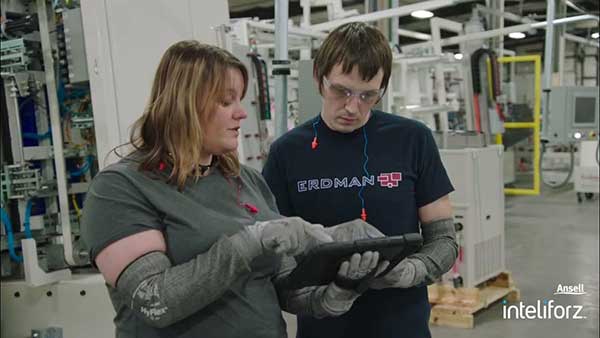Faced with fewer and less experienced workers, manufacturers are looking to workplace safety tech to keep employees safe and productive.

By Stephanie Gifford, Senior Manager of Business Development at Ansell Inteliforz™
Manufacturers enter 2023 fending off a vicious cycle of declining labor availability and increasing workplace injuries.
No industry has been hit harder by the Great Resignation (voluntary departures surged nearly 60 percent during the first two years of the pandemic) and the industry is projected to have 2.1 million unfilled jobs by 2030. With fewer and less experienced workers on the floor and e-commerce demand straining capacity, injuries become more common and the workforce shrinks even further.
Slowing or reversing this self-perpetuating cycle will require businesses to rethink their workplace safety programs in 2023. As the labor shortage wears on, expect companies to increase investment in technology solutions that prevent injuries, bolster retention and keep workers happy and productive.
Not only has the manufacturing industry been hit hard by the Great Resignation, its frontline workers have also been heavily impacted by the supply chain issues triggered by the pandemic. Many teams are not only shorthanded, but required to work longer hours and rest less frequently as businesses fight to keep up with demand.
That creates the perfect storm for burnout and repetitive motion injuries. The average musculoskeletal disorder (MSD) keeps an employee off the job for 12 days, an eternity for teams already at critical numbers.
Ergonomic analysis is key to preventing injuries in these conditions. But the traditional approach, which requires manual inspection and can take weeks or months to record data and implement changes, will need to be replaced with modern, technology-enabled programs with a more employee-centered approach.
Wearable technology, for example, can monitor hand and wrist motion and use AI software to identify movement that puts workers at increased risk of injury. The wearable can send a gentle signal to remind the worker to use the form on which they were trained. Safety teams, meanwhile, can analyze data across the workforce to measure and optimize the efficacy of their training programs.
The economic realities of 2023 will no doubt limit budgets. Technologies that are easy to use, can train employees quickly and, critically, improve ROI in both the short and long term will be prioritized. Organizations will look to unified platforms that offer multiple safety solutions—like injury detection, training support and communication—under one roof in order to keep costs low and the work of setup and integration simple. Attempting to piece together disparate solutions will not only add expense but bog down staff resources as they work to keep the integrations in working order.
Finding the right solutions requires more than just resource investment—it requires putting in the time and effort to learn more about available solutions and deciding which is the right fit for a specific organization and its workforce. Expect more manufacturers to attend technology and ergonomics shows and training in 2023 as they step up their efforts to identify solutions.
Not all solutions, by the way, will be technology centered. Expect onsite and consultative services with healthcare providers and ergonomists to be in higher demand as companies work to prevent injuries and provide modifications to the job site.
Frontline workers know their value and won’t stick around with employers who treat them as replaceable cogs in the machine. The labor force will experience a shift, aligning with companies who value workers’ skill sets and protect their health and ability to make a living.
In a recent survey, 94 percent of frontline industrial workers said it is “very important” that their employer prioritizes their physical safety and three out of four said they are more likely to join or stay with an employer who clearly prioritizes their physical safety.
That same report found that nine out of 10 workers are interested in wearing connected technology that warns against unsafe movements.
Investment in such technology does more than help prevent injuries; it’s a direct reflection of the company’s values and culture. Building an innovative, modern safety program sends a clear signal that an employer takes seriously the wellbeing of its employees… and is willing to back that commitment up with tangible resources.
Businesses that invest in new technology, build robust training programs and emphasize the importance of proper form and taking breaks will be paid back by improved recruitment and retention numbers.
In the end, these companies will have happier, healthier workforces and a more sustainable future.
Stephanie Gifford, OTR/L, CKTP, CLT, CPNE, CDRS is the Business Development Manager for North America for Ansell’s Inteliforz. She has a background as an Occupational Therapist working in hand therapy, industrial wellness, ergonomics and technology solutions. Stephanie’s passion is utilizing disruptive technologies to improve health and safety in the workplace. She is a former business owner and has been in the medical device sales industry for over 10 years. Stephanie resides in Tampa, Florida and is available for meetings in person or virtually.
Scott Ellyson, CEO of East West Manufacturing, brings decades of global manufacturing and supply chain leadership to the conversation. In this episode, he shares practical insights on scaling operations, navigating complexity, and building resilient manufacturing networks in an increasingly connected world.